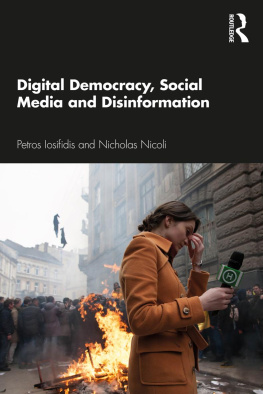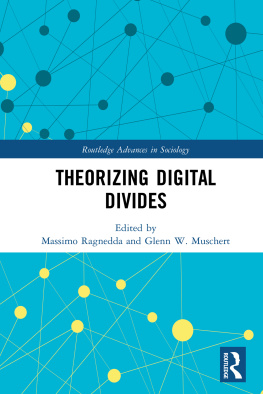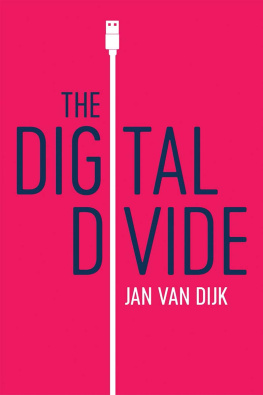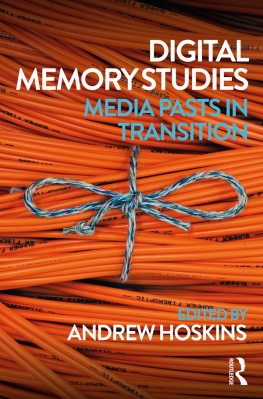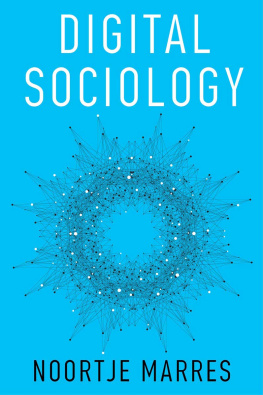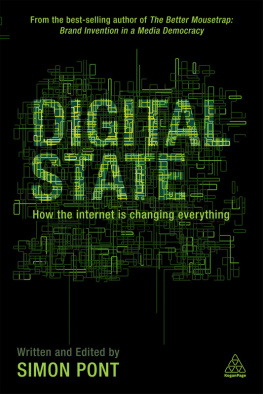Superconnected
The Internet, Digital Media, and Techno-Social Life
For Paula Van Riper, activist, educator, warrior, friend
Superconnected
The Internet, Digital Media, and Techno-Social Life
- Mary Chayko
- Rutgers University
FOR INFORMATION:
SAGE Publications, Inc.
2455 Teller Road
Thousand Oaks, California 91320
E-mail: order@sagepub.com
SAGE Publications Ltd.
1 Olivers Yard
55 City Road
London EC1Y 1SP
United Kingdom
SAGE Publications India Pvt. Ltd.
B 1/I 1 Mohan Cooperative Industrial Area
Mathura Road, New Delhi 110 044
India
SAGE Publications Asia-Pacific Pte. Ltd.
3 Church Street
#10-04 Samsung Hub
Singapore 049483
Copyright 2017 by SAGE Publications, Inc.
All rights reserved. No part of this book may be reproduced or utilized in any form or by any means, electronic or mechanical, including photocopying, recording, or by any information storage and retrieval system, without permission in writing from the publisher.
Printed in the United States of America
Library of Congress Cataloging-in-Publication Data
Names: Chayko, Mary, 1960- author.
Title: Superconnected: the Internet, digital media, and techno-social life / Mary Chayko.
Description: Los Angeles: SAGE, [2017] | Includes bibliographical references and index.
Identifiers: LCCN 2015038733 | ISBN 978-1-4522-6879-8 (pbk.: alk. paper)
Subjects: LCSH: Information technologySocial aspects. | InternetSocial aspects. | Digital media. | Information society.
Classification: LCC HM851 .C4335 2017 | DDC 303.48/33dc23 LC record available at http://lccn.loc.gov/2015038733
This book is printed on acid-free paper.
Acquisitions Editor: Jeff Lasser
Development Editor: Nathan Davidson
Editorial Assistant: Alex Croell
Production Editor: Veronica Stapleton Hooper
Copy Editor: Shannon Kelly
Typesetter: C&M Digitals (P) Ltd.
Proofreader: Jennifer Grubba
Indexer: Jean Casalegno
Cover Designer: Scott Van Atta
Marketing Manager: Johanna Swenson
About the Author
Dr. Mary Chaykois a sociologist, Teaching Professor of Communication and Information, and Director of Undergraduate Interdisciplinary Studies at the School of Communication and Information (SC&I) at Rutgers University. She is also an affiliate member of the graduate faculty of the Department of Sociology and an affiliate member of the faculty of the Department of Womens and Gender Studies at Rutgers. She received her B.A. in Communication and Psychology, Ed.M. in Counseling Psychology, and M.A. and Ph.D. in Sociology from Rutgers University.
Dr. Chaykos research is on the impact of the internet and digital technology on community, society, and self. She is the author of
Portable Communities: The Social Dynamics of Online and Mobile Connectedness and
Connecting: How We Form Social Bonds and Communities in the Internet Age, both with SUNY Press, as well as many published articles. With Corey Dolgon she coedited the anthology
Pioneers in Public Sociology: Thirty Years of Humanity and Society with Sloan Publishing. She speaks widely on the topic of digital technology and its societal impacts and has been honored as a Rutgers University Faculty of Arts and Sciences Distinguished Contributor to Undergraduate Education.
Dr. Chayko can be reached at mary.chayko@rutgers.edu, on Twitter@MaryChayko, and via her website at marychayko.com. The site contains excerpts from her published works, media appearances, and even some of her music. In her spare time, she is a singer and flutist in a folky, social justiceoriented band with fellow sociologists Jim Pennell and Corey Dolgon, whose CD
Songs of Peace and Justice can be heard on the website.
Superconnected
The first thing you should know about this book is that the title is partly a misnomer. Yes, our societies are superconnected, and so are wenever in human history have so many been connected to so many others, in so many ways, with such wide-ranging social implications. But sometimes it is assumed that the whole world is wired, living in a state of electronic connectivity, and thats just not the case. There are places in the world, such as much of southern Asia and sub-Saharan Africa, in which internet access, computers, and even electricity are seriously scarce. About a quarter of the worlds population does not have regular access to electricity, and although cell phones have penetrated the developing world to a much greater extent than computers have, they are used in much more limited ways than they are in more technologically developed areas, and owners are often hindered by inconsistent internet access, unreliable service, and the inability to regularly charge their phones (Gronewold, 2009; International Telecommunications Union [ITU], 2014; McKinsey and Company, 2014; Pew Research Centers Global Attitudes Project, 2012).
So when we talk about technological connectedness via the internet, digital and social media, and mobile phone use, as we will throughout this book, we must keep in mind that these things are not equally available to or experienced by everyone. There are social divisions and differences which influence whether and how people go online and make connections, even in highly developed countries like the United States and Canada. Most people who do not have regular internet access live in rural areas where poor infrastructure, health care, education, and employment opportunities impede internet adoption and use. About one-fourth of the offline population is illiterate. Others are offline by choice (Dutta, Geiger, & Lanvin, 2015; Ferdman, 2014; McKinsey and Company, 2014).
Internet connectedness is a reflection of the ways in which social factors like socioeconomic status, educational background, race, ethnicity, gender, age, sexual orientation, and so on play out in the physical world. This is because the online, digital world is not a separate entity from the offline, physical world. It is part of it. Online activity can make more visible and amplify concerns, problems, and divisions that are part of social life in physical space, and it can raise concern about new issues, too. But the digital world is in every way real and is deeply integrated with everyday lived experiences and with the future of our societiesand ourselveswhich makes it critically important to examine and understand.
Though obstacles remain to worldwide digital access and to the full realization of the potential of these technologies for all, the internet and digital media still afford tremendous opportunities for social connectedness and social change. They have become embedded in nearly every facet of modern life, including cities, cars, home appliances, lighting and heating products, and health and lifestyle monitoring. In all kinds of spaces, from the global to the local and everything in between, individuals and their communities and societies have become interconnected, their lives dramatically affected, their environments increasingly saturated with technology. So in the end, the title of this book still seems appropriate... because to an extent previously unimagined, and with the almost unlimited potential for further integration, the world has indeed become technologically and socially


